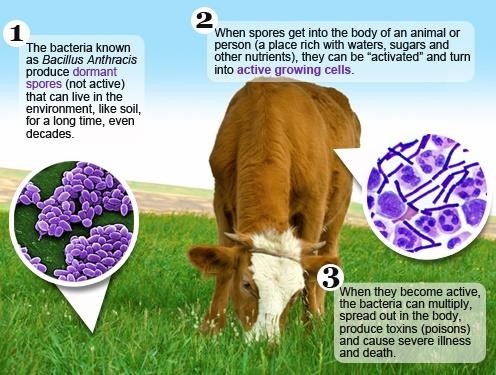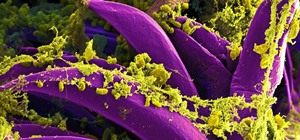An outbreak of anthrax from contaminated meat in Tanzania sickened dozens of people and moves the danger of this deadly bacteria back into focus.
Naturally occurring in animals and the soil, Bacillus anthracis is a rugged bacteria that has a protective outer shell, called a spore, that allows it to withstand conditions that would kill other pathogens.
A rod-shaped bacteria, anthrax is found around the world, but outbreaks are currently more prevalent in the Middle East, Africa, and Asia. Known since ancient times, anthrax is not contagious, but fatal when ingested, inhaled, or when the bacterium enters the body through a cut or scrape. In the human body, anthrax manufactures proteins that cause hemorrhaging and organ damage.
The route by which anthrax arrives in the body impacts the type of infection that results:
- Cutaneous is the most common form of anthrax, and occurs with direct skin contact with the bacterium. Infection usually occurs within a week of exposure.
- Gastrointestinal anthrax occurs when the spores are ingested, and infection also develops within about a week. This is a rarity in the US.
- Inhalation is the most serious form of anthrax infection. Often deadly, illness can develop within a week, or take as long as two months to infect lymph nodes and spread throughout the body.
Anthrax Outbreaks in Africa & Australia
Recent incidents in Tanzania and Australia offer a reminder of the danger of anthrax.
People from the three villages of Sanya Station, Tindigani, and Nkwasira, in the northern area of the Hai District in Tanzania, were exposed to anthrax after eating the meat of a contaminated cow. At least 36 people arrived at local hospitals with symptoms including skin lesions and swollen eyes.
So far, no deaths have been reported from the disease. Last April, the nearby Rombo District suffered an outbreak that sickened several villagers and killed one person.
In the current outbreak, health officials provided guidance on anthrax symptoms, livestock vaccinations, and precautions to villagers to understand safe handling of meat. "This is so because people in the affected villages have a tendency of eating meat which wasn't approved by the responsible authorities," noted Elias Machange, Head of the regional Livestock and Fisheries Department, in a news report.

In early March, in Australia, livestock were impacted when an anthrax outbreak killed 80 cattle on contaminated grazing property. Recent heavy rains may have dislodged soil that subsequently spread the spores to the cattle. Authorities, alerted by the farmer due to the sudden death of a large number of animals, carried out disposal of the cattle and vaccination of remaining stock.
A second outbreak of anthrax in Australia was identified on a sheep farm where sheep had been dying for several months. Only one sheep was confirmed to have died from anthrax, due to the advanced state of decomposition of the bodies of the earlier sheep. While the two farms afflicted by these outbreaks have a business relationship, authorities are treating the events as separate. Prior to these incidents, Australia had not experienced an anthrax outbreak since 2002.
Anthrax as a Potential Bioweapon
As a naturally occurring pathogen, anthrax has a formidable reputation. Unfortunately, anthrax is also considered a potential risk for use as a bioweapon.
The Centers for Disease Control and Prevention note the first use of anthrax in an act of aggression occurred during World War I, when the Germans reportedly contaminated livestock and animal feed. In 1972, 140 nations signed a treaty agreeing to ban the production and stockpiling of biological weapons.
In 2001, just after the terrorist attacks on the World Trade Towers and the Pentagon, letters containing anthrax spores were mailed to politicians and members of the media. During the attack, 43 people tested positive for exposure to anthrax, 22 people were sickened, and five people died. Overall, 10,000 people were considered at risk from the attack. In 2008, a government scientist considered as a suspect in the case committed suicide. There remains no definitive scientific proof as to who conducted the attack.
Because of its stability, anthrax could be spread via skin contact or through a weapon that aerosolizes the bacteria. Victims of the 2001 suffered suffered both cutaneous and respiratory exposure. It is estimated an airborne weapon could impact millions of people on release.
One potential drawback to the use of anthrax as a bioweapon is the difficulty of weaponizing the bacteria. The development of anthrax as a weapon requires significant technological resources more often associated with a government-sponsored facility. At present, the greatest threat is considered to be from terrorists who may have less access to the technology required than nation-state actors.
Anthrax is an old pathogen that continues to plague people and animals around the world. In the US, human exposure to anthrax is rare. Let's hope it stays that way.
Just updated your iPhone? You'll find new emoji, enhanced security, podcast transcripts, Apple Cash virtual numbers, and other useful features. There are even new additions hidden within Safari. Find out what's new and changed on your iPhone with the iOS 17.4 update.






























Be the First to Comment
Share Your Thoughts